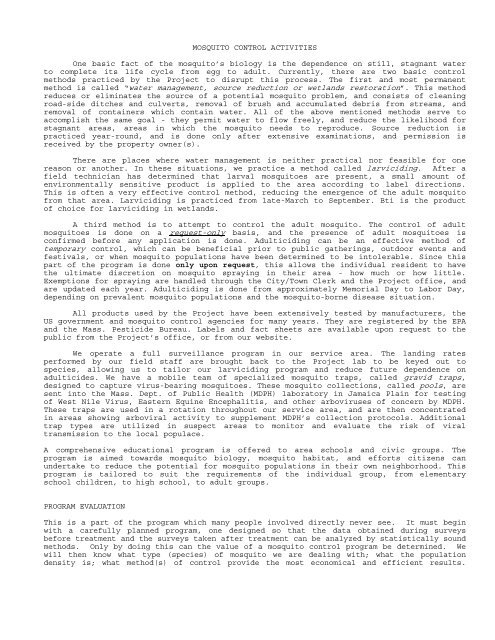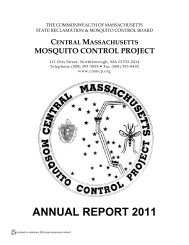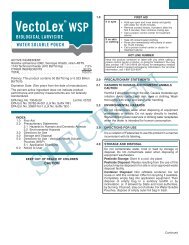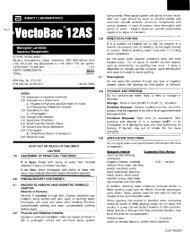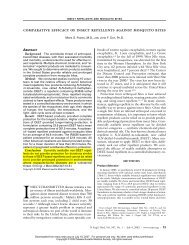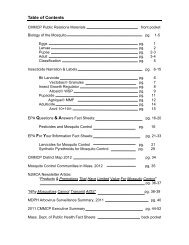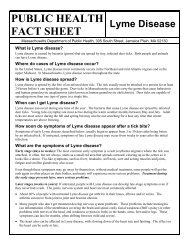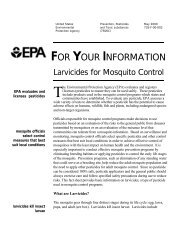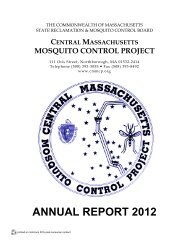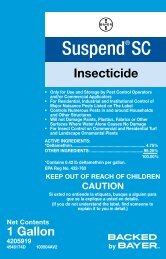marlboro - Central Mass. Mosquito Control
marlboro - Central Mass. Mosquito Control
marlboro - Central Mass. Mosquito Control
Create successful ePaper yourself
Turn your PDF publications into a flip-book with our unique Google optimized e-Paper software.
MOSQUITO CONTROL ACTIVITIES<br />
One basic fact of the mosquito’s biology is the dependence on still, stagnant water<br />
to complete its life cycle from egg to adult. Currently, there are two basic control<br />
methods practiced by the Project to disrupt this process. The first and most permanent<br />
method is called “water management, source reduction or wetlands restoration”. This method<br />
reduces or eliminates the source of a potential mosquito problem, and consists of cleaning<br />
road-side ditches and culverts, removal of brush and accumulated debris from streams, and<br />
removal of containers which contain water. All of the above mentioned methods serve to<br />
accomplish the same goal - they permit water to flow freely, and reduce the likelihood for<br />
stagnant areas, areas in which the mosquito needs to reproduce. Source reduction is<br />
practiced year-round, and is done only after extensive examinations, and permission is<br />
received by the property owner(s).<br />
There are places where water management is neither practical nor feasible for one<br />
reason or another. In these situations, we practice a method called larviciding. After a<br />
field technician has determined that larval mosquitoes are present, a small amount of<br />
environmentally sensitive product is applied to the area according to label directions.<br />
This is often a very effective control method, reducing the emergence of the adult mosquito<br />
from that area. Larviciding is practiced from late-March to September. Bti is the product<br />
of choice for larviciding in wetlands.<br />
A third method is to attempt to control the adult mosquito. The control of adult<br />
mosquitoes is done on a request-only basis, and the presence of adult mosquitoes is<br />
confirmed before any application is done. Adulticiding can be an effective method of<br />
temporary control, which can be beneficial prior to public gatherings, outdoor events and<br />
festivals, or when mosquito populations have been determined to be intolerable. Since this<br />
part of the program is done only upon request, this allows the individual resident to have<br />
the ultimate discretion on mosquito spraying in their area - how much or how little.<br />
Exemptions for spraying are handled through the City/Town Clerk and the Project office, and<br />
are updated each year. Adulticiding is done from approximately Memorial Day to Labor Day,<br />
depending on prevalent mosquito populations and the mosquito-borne disease situation.<br />
All products used by the Project have been extensively tested by manufacturers, the<br />
US government and mosquito control agencies for many years. They are registered by the EPA<br />
and the <strong>Mass</strong>. Pesticide Bureau. Labels and fact sheets are available upon request to the<br />
public from the Project’s office, or from our website.<br />
We operate a full surveillance program in our service area. The landing rates<br />
performed by our field staff are brought back to the Project lab to be keyed out to<br />
species, allowing us to tailor our larviciding program and reduce future dependence on<br />
adulticides. We have a mobile team of specialized mosquito traps, called gravid traps,<br />
designed to capture virus-bearing mosquitoes. These mosquito collections, called pools, are<br />
sent into the <strong>Mass</strong>. Dept. of Public Health (MDPH) laboratory in Jamaica Plain for testing<br />
of West Nile Virus, Eastern Equine Encephalitis, and other arboviruses of concern by MDPH.<br />
These traps are used in a rotation throughout our service area, and are then concentrated<br />
in areas showing arboviral activity to supplement MDPH’s collection protocols. Additional<br />
trap types are utilized in suspect areas to monitor and evaluate the risk of viral<br />
transmission to the local populace.<br />
A comprehensive educational program is offered to area schools and civic groups. The<br />
program is aimed towards mosquito biology, mosquito habitat, and efforts citizens can<br />
undertake to reduce the potential for mosquito populations in their own neighborhood. This<br />
program is tailored to suit the requirements of the individual group, from elementary<br />
school children, to high school, to adult groups.<br />
PROGRAM EVALUATION<br />
This is a part of the program which many people involved directly never see. It must begin<br />
with a carefully planned program, one designed so that the data obtained during surveys<br />
before treatment and the surveys taken after treatment can be analyzed by statistically sound<br />
methods. Only by doing this can the value of a mosquito control program be determined. We<br />
will then know what type (species) of mosquito we are dealing with; what the population<br />
density is; what method(s) of control provide the most economical and efficient results.


